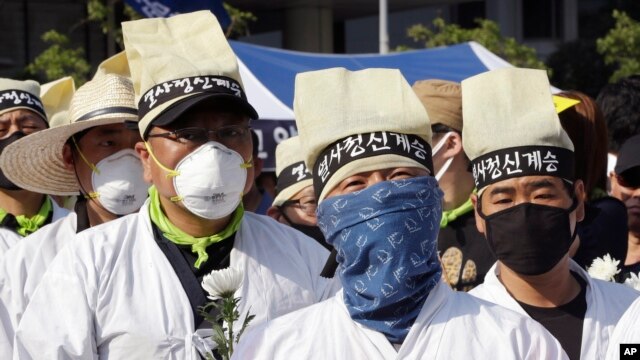
Protesters wear masks as a precaution against the MERS, Middle East Respiratory Syndrome, virus during a rally against government's labor policy in Seoul, South Korea, Sunday, June 7, 2015.
While the number of Middle East Respiratory Syndrome (MERS) cases in South Korea increased to 87 Monday with six related deaths, there is reason to believe the outbreak is being contained. The deadly virus has not spread outside of hospital settings or significantly beyond those people who were exposed to the first Korean patient infected with the deadly virus.
Over the weekend South Korea’s Ministry of Health and Welfare released the names of six hospitals where MERS patients are being treated and 18 others where MERS patients visited.
After being criticized by some public health experts and lawmakers, including the mayor of Seoul, for a lack of transparency and a slow response to the crisis, the prime minister’s office Sunday vowed an “all out “ effort to deal with the outbreak.
Two hospitals on the list account for 71 of the 87 confirmed MERS cases. These are St. Mary’s Hospital in Pyeongtaek, located 80 kilometers south of the capital city, and the Samsung Medical Center, located in Seoul.
The spike in infections can be traced back to the first Korean patient diagnosed with MERS, a 68-year-old man, who visited both hospitals after returning from the Middle East in May. Patient 1 has been described as an extremely contagious “super spreader.”
Last week the outbreak centered around St. Mary’s Hospital in Pyeongtaek where 37 MERS cases have been reported. But Kwon Deok-chul, director of the national MERS management team within the Health Ministry, said the situation there is improving.
Kwon said no new cases were found at the St. Mary’s hospital for the first time. So it is their assessment, he said, that this part of the outbreak at Pyeongtaek St. Mary's hospital has ended.
Most of the recent cases have come from the Samsung Medical Center in Seoul. Kwon said the number of infections there will soon or already have peaked and projects that the outbreak will start to decrease at the Samsung Seoul hospital as well.
MERS is a respiratory illness that initially produces flu-like symptoms, but can escalate to pneumonia and kidney failure. It was first identified in Saudi Arabia in 2012. There is no known cure or vaccine.
But MERS becomes increasingly less contagious as it is spread from one person to the next. In Korea those infected by patient 1, the “super spreader,” have in turn infected relatively few third generation MERS cases.
Health authorities say the virus has not spread beyond the hospitals where the MERS virus was found.
To prevent any further outbreaks, over 2,000 people have been placed under quarantine orders. Government officials say they are also tracking the mobile phones of those under house quarantine to ensure they stay home.
This week officials expect to discharge hundreds of patients under observation if they exhibit no symptoms of the disease once the 14-day incubation period is complete.
Nearly 2,000 schools have also been closed. And hundreds of public events, school trips and sporting events have been canceled.
The sixth person to die from this MERS outbreak was a man in his 80s. On average one in four people infected with it die as a result, although most of those who died also had other serious health issues.
The World Health Organization also announced that it was sending a team of experts on Tuesday to assist South Korea’s investigation into the cause of the outbreak. |
|
